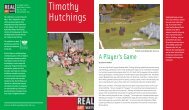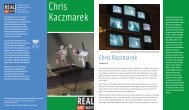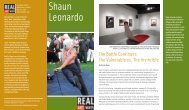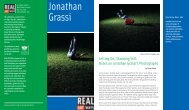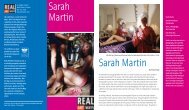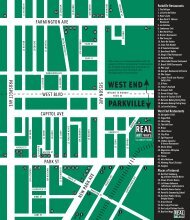Sarah Emerson - Real Art Ways
Sarah Emerson - Real Art Ways
Sarah Emerson - Real Art Ways
You also want an ePaper? Increase the reach of your titles
YUMPU automatically turns print PDFs into web optimized ePapers that Google loves.
This exhibition is a result of <strong>Real</strong> <strong>Art</strong><br />
<strong>Ways</strong>’ “Don’t Trust Anyone Over 30”<br />
competition in 2003, which requested<br />
proposals from emerging artists age<br />
thirty and younger, living in New<br />
York or New England. Under 30 was<br />
juried by Jennifer Gross, Curator of<br />
Contemporary <strong>Art</strong>, Yale University<br />
<strong>Art</strong> Gallery, Barbara Hunt, Executive<br />
Director, <strong>Art</strong>ists Space, New York,<br />
and Barbara Krakow, President,<br />
Barbara Krakow Gallery.<br />
The exhibition was made<br />
possible by a grant from<br />
the National Endowment<br />
for the <strong>Art</strong>s.<br />
56 ARBOR STREET<br />
HARTFORD CT 06106<br />
860 232 1006<br />
REALARTWAYS.ORG<br />
<strong>Sarah</strong><br />
<strong>Emerson</strong><br />
Endless Night, acrylic and rhinestones on canvas, 66 x 56”, 2003.<br />
<strong>Sarah</strong> <strong>Emerson</strong> graduated<br />
from the Atlanta College of <strong>Art</strong><br />
in 1997 and went on to<br />
complete her Master’s Degree<br />
in 2000 at Goldsmiths College<br />
in London, England. She has<br />
been living and working in<br />
Brooklyn, NY since 2001.<br />
Over the last ten years, she<br />
has exhibited her paintings<br />
in museums and galleries<br />
throughout the United States<br />
and Europe, including at<br />
White Columns, New York,<br />
Cosmic Gallery, Paris, and<br />
<strong>Real</strong> <strong>Art</strong> <strong>Ways</strong>, Hartford, CT.<br />
REAL ART WAYS, founded in 1975, is<br />
a nationally recognized, alternative<br />
multi-disciplinary arts organization<br />
that presents and supports contemporary<br />
artists and their work,<br />
facilitates the creation of new work,<br />
and creatively engages and informs<br />
audiences and communities. <strong>Real</strong><br />
<strong>Art</strong> <strong>Ways</strong> is an active presenter of<br />
different art forms, including music,<br />
performance, spoken word, film,<br />
video and visual arts. <strong>Real</strong> <strong>Art</strong> <strong>Ways</strong><br />
has a particular commitment to<br />
supporting the work of emerging<br />
artists.<br />
The Darker Side of Sweet<br />
Animals first entered the imagination as messengers and promises. 1 —John Berger<br />
By Denise Markonish<br />
On December 15, 2004 the woodland creatures revolted. They were messengers all right but not<br />
quite in the way that John Berger was speaking of; they didn’t bring promises or any type of<br />
virtue, instead these seemingly benign critters brought evil. Only in the twisted minds of Trey<br />
Parker and Matt Stone could this scenario play out, that is…only on South Park. In the season<br />
8 episode entitled “Woodland Critters Christmas” a gang of cute little animals, big-eyed deer,<br />
twitchy nosed mice, and curly tailed squirrels, find Stan (one of the show’s characters) and<br />
enlist him to build them a manger for the anticipated birth of their “lord and savior.” Unsuspecting<br />
Stan can’t resist the cute critters and he helps them out only to find that they are celebrating<br />
the birth of Satan.<br />
On the cover: Under the Milky Way, acrylic on canvas, 60 x 62”, 2004. (detail)<br />
This scenario just goes to show, in an admittedly exaggerated manner, that we as humans really<br />
do not know who animals are and what they do when we are not present. We have ideas about
the lives animals live and what they do when we are not looking.<br />
We also anthropomorphize animals to such a degree<br />
that they become almost human in our eyes, which is why we<br />
are so often shocked when an animal attacks, or acts like,<br />
well… an animal. When I happened upon this episode of<br />
South Park, I was immediately reminded of the paintings of<br />
<strong>Sarah</strong> <strong>Emerson</strong>, which contain a similar dichotomy between a<br />
Disney-like saccharine sweetness and a lurking darkness<br />
beneath this surface. <strong>Emerson</strong>’s paintings catch animals and<br />
they in turn catch us looking at them, a confrontation not<br />
unlike Stan and the woodland creatures, where man and<br />
animal can really see each other, even if only for a brief<br />
moment.<br />
<strong>Emerson</strong>’s paintings present viewers with highly stylized<br />
versions of nature by taking patterns already visible in the<br />
natural world, ground cover, leaves, moss, flowers and<br />
branches, and painting them in pastel hues and pop-like<br />
repetition. These pictures almost look like paint by numbers,<br />
but <strong>Emerson</strong> adds in references to animation and folk art both<br />
in her use of decoration and color. A colorful bird sits on a<br />
cartoon-like tree, or, in Under the Milky Way, a Bambi-like<br />
deer gazes at the full moon amidst a field of flowers. All of<br />
<strong>Emerson</strong>’s landscapes are then inhabited by animals. However,<br />
it is the dichotomy between sweet and terrifying in<br />
<strong>Emerson</strong>’s paintings that is most striking, as cute woodland<br />
Under the Milky Way, acrylic on canvas, 60 x 62”, 2004.<br />
Wrest Away, acrylic on canvas, 60 x 66”, 2004.<br />
critters are engulfed by flames, then wolves growl, and<br />
crows peck at the ground.<br />
Most often <strong>Emerson</strong> depicts deer, a nod to the influential<br />
1942 Disney classic Bambi in which innocence and terror go<br />
hand in hand. <strong>Emerson</strong>’s deer, however, are less innocent<br />
than their Disney-fied cousin. In Endless Night a male and<br />
female deer confront the viewer as crows menacingly peck at<br />
spots of blood in the background. The deer stare straight out<br />
at us, almost challenging our trespassing in their forest. In<br />
viewing this painting you can feel the protective stare of the<br />
stag as he stands in the foreground, protecting both his mate<br />
and his forest, a gesture that is both startling and tender.<br />
<strong>Emerson</strong> adds yet another<br />
twist to her images by adding<br />
to these already stylized<br />
paintings Swarovski crystals.<br />
Pools of blood are covered in<br />
red crystals that shimmer and<br />
sparkle from across the room,<br />
as if sunlight is glinting off<br />
the blood’s surface. It is<br />
strange to see something so<br />
horrible made into a thing of<br />
beauty, it draws you in from<br />
across the room, only to have<br />
you recoil at the thought of<br />
what is actually represented.<br />
In other instances the rhinestones<br />
highlight the delicate<br />
curves and contours of flower<br />
petals. Seesawing back and<br />
forth between the sweet and<br />
the sick, the use of these<br />
reflective elements adds<br />
yet another level of eerie<br />
enchantment to these images.<br />
In other paintings, <strong>Emerson</strong><br />
gets even darker. Still<br />
employing her signature pastel<br />
tones, <strong>Emerson</strong> has painted a series of wolves and birds.<br />
In the painting Wrest Away, two wolves glare up at the viewer<br />
as one more continues feeding upon a deer carcass. You get<br />
the sense that you are interrupting something you shouldn’t<br />
be. It is one of those moments that humans don’t usually see<br />
animals in, unless it is on the safety of the television. But<br />
<strong>Emerson</strong> paints her wolves with such visceral emotion that<br />
you can almost feel their bloody slobber as they growl at your<br />
intrusion.<br />
A similarly bloody mess is present in The Bend, where a<br />
motley crew of crows picks at bits of carrion, ripping dead<br />
flesh from felled deer. You can almost imagine the scenario<br />
where wolf kills deer and in come the birds. Or is it man<br />
who has caused this destruction, as in Bambi, and the woodland<br />
denizens just leapt at the opportunity? What is most<br />
striking in both of these instances is that once the reality<br />
of the scenes wears off, <strong>Emerson</strong> still manages to present to<br />
us images possessing amazing elegance and beauty that<br />
once again enchant us with the idea of what animals can be<br />
and mean to us.<br />
<strong>Sarah</strong> <strong>Emerson</strong>’s work provides insight into the activity of<br />
animals but these images, just like Bambi or South Park, are<br />
fictions drawn from reality and twisted in the mind of the<br />
artist. <strong>Emerson</strong> makes us think about what animals do when<br />
we are not looking and what happens when we intrude into<br />
their territory. She also allows us to look deeply and discover,<br />
in nature, patterns and artifice that we never knew<br />
before. Her work embodies a merging of fact and fiction,<br />
reality and stylization and most importantly innocence and<br />
despair. In the end, the animals of <strong>Emerson</strong>’s paintings do<br />
indeed enter into our imagination as both promises and<br />
messengers of the darker side of sweet.<br />
The Bend, acrylic and rhinestones on canvas, 70 x 56”, 2002.<br />
Collection of Claudia Cargnel and Fred Bugada.<br />
Denise Markonish is the curator at <strong>Art</strong>space in New Haven, CT.<br />
1 John Berger, “Why Look at Animals” in About Looking (New York: Pantheon<br />
Books, 1980). Page 2.



